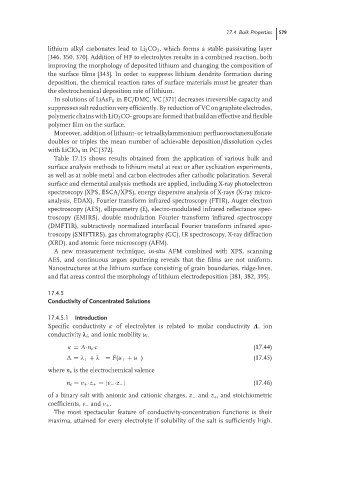Page 605 - Handbook of Battery Materials
P. 605
17.4 Bulk Properties 579
lithium alkyl carbonates lead to Li 2 CO 3 , which forms a stable passivating layer
[346, 350, 370]. Addition of HF to electrolytes results in a combined reaction, both
improving the morphology of deposited lithium and changing the composition of
the surface films [343]. In order to suppress lithium dendrite formation during
deposition, the chemical reaction rates of surface materials must be greater than
the electrochemical deposition rate of lithium.
In solutions of LiAsF 6 in EC/DMC, VC [371] decreases irreversible capacity and
suppresses salt reduction very efficiently. By reduction of VC on graphite electrodes,
polymeric chains with LiO 2 CO- groups are formed that build an effective and flexible
polymer film on the surface.
Moreover, addition of lithium- or tetraalkylammonium perfluorooctanesulfonate
doubles or triples the mean number of achievable deposition/dissolution cycles
with LiClO 4 in PC [372].
Table 17.15 shows results obtained from the application of various bulk and
surface analysis methods to lithium metal at rest or after cyclization experiments,
as well as at noble metal and carbon electrodes after cathodic polarization. Several
surface and elemental analysis methods are applied, including X-ray photoelectron
spectroscopy (XPS, ESCA/XPS), energy dispersive analysis of X-rays (X-ray micro-
analysis, EDAX), Fourier transform infrared spectroscopy (FTIR), Auger electron
spectroscopy (AES), ellipsometry (E), electro-modulated infrared reflectance spec-
troscopy (EMIRS), double modulation Fourier transform infrared spectroscopy
(DMFTIR), subtractively normalized interfacial Fourier transform infrared spec-
troscopy (SNIFTIRS), gas chromatography (GC), IR spectroscopy, X-ray diffraction
(XRD), and atomic force microscopy (AFM).
A new measurement technique, in-situ AFM combined with XPS, scanning
AES, and continuous argon sputtering reveals that the films are not uniform.
Nanostructures at the lithium surface consisting of grain boundaries, ridge-lines,
and flat areas control the morphology of lithium electrodeposition [381, 382, 395].
17.4.5
Conductivity of Concentrated Solutions
17.4.5.1 Introduction
Specific conductivity κ of electrolytes is related to molar conductivity Λ,ion
conductivity λ i , and ionic mobility u i .
κ = ·n e ·c (17.44)
= λ + + λ − = F(u + + u − ) (17.45)
where n e is the electrochemical valence
n e = v + ·z + =|v − ·z − | (17.46)
of a binary salt with anionic and cationic charges, z − and z + , and stoichiometric
coefficients, ν − and ν + .
The most spectacular feature of conductivity-concentration functions is their
maxima, attained for every electrolyte if solubility of the salt is sufficiently high.

